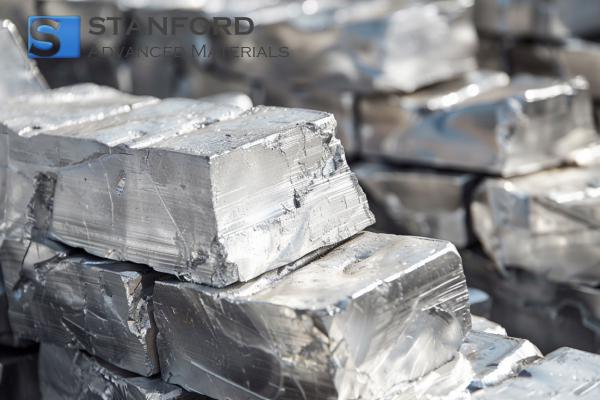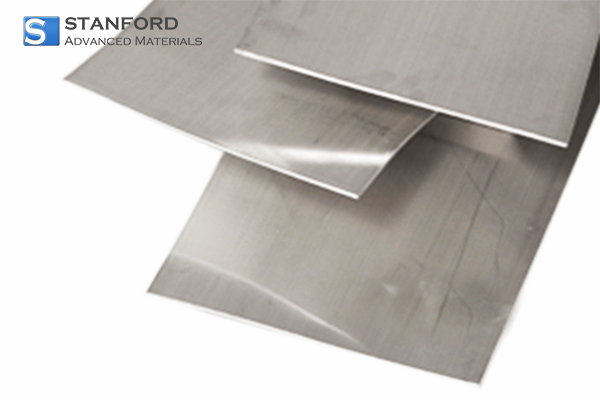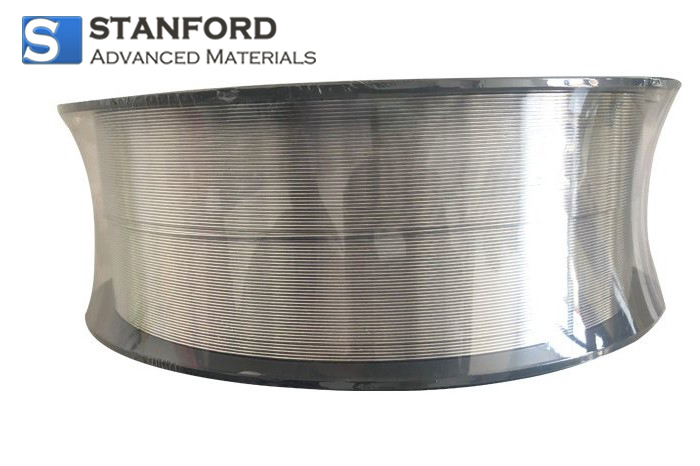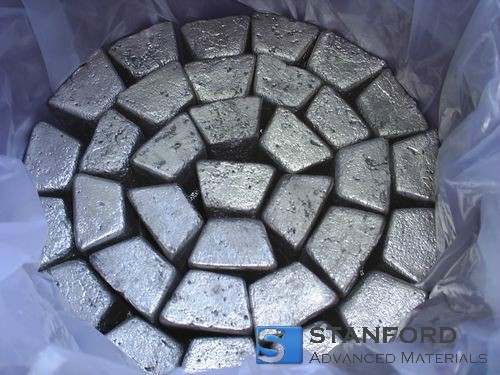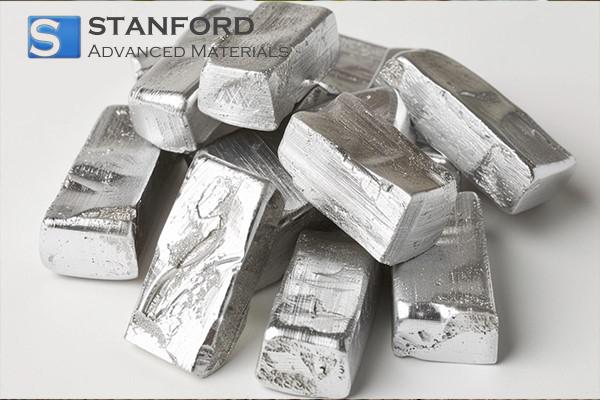SECTION 1. IDENTIFICATION
Product Name: Aluminum Manganese Tubing
CAS #:
Relevant identified uses of the substance: Scientific research and development
Supplier details:
Stanford Advanced Materials
E-mail: sales@samaterials.com
Tel: (949) 407-8904
Address: 23661 Birtcher Dr., Lake Forest, CA 92630 U.S.A.
SECTION 2. HAZARDS IDENTIFICATION
Classification of the substance or mixture
GHS Classification in accordance with 29 CFR 1910 (OSHA HCS)
Acute aquatic toxicity(Category 2), H401
GHS Label elements, including precautionary statements
Pictogram
none
Signal word
none
Hazard statement(s)
H401
Toxic to aquatic life.
Precautionary statement(s)
P273
Avoid release to the environment.
P501
Dispose of contents/ container to an approved waste disposal plant.
Hazards not otherwise classified (HNOC) or not covered by GHS-none
SECTION 3. COMPOSITION/INFORMATION ON INGREDIENTS
Substances
Formula: Al
CAS-No.: 7429-90-5
EC-No.: 231-072-3
Formula: Mn
CAS-No: 7439-96-5
EC number: 231-105-1
SECTION 4. FIRST AID MEASURES
Description of first aid measures
General advice
Consult a physician. Show this safety data sheet to the doctor in attendance.
Move out of dangerous area.
If inhaled
If breathed in, move person into fresh air. If not breathing, give artificial respiration. Consult a
physician.
In case of skin contact
Wash off with soap and plenty of water. Consult a physician.
In case of eye contact
Flush eyes with water as a precaution.
If swallowed
Never give anything by mouth to an unconscious person. Rinse mouth with water. Consult a physician.
Most important symptoms and effects, both acute and delayed
The most important known symptoms and effects are described in the labelling (see section 2) and/or
in section 11
Indication of any immediate medical attention and special treatment needed
No data available
SECTION 5. FIREFIGHTING MEASURES
Extinguishing media
Suitable extinguishing media
Use water spray, alcohol-resistant foam, dry chemical or carbon dioxide.
Special hazards arising from the substance or mixture
Manganese/manganese oxides
Advice for firefighters
Wear self-contained breathing apparatus for firefighting if necessary.
Further information
No data available
SECTION 6. ACCIDENTAL RELEASE MEASURES
Personal precautions, protective equipment and emergency procedures
Avoid dust formation. Avoid breathing Vapors, mist or gas. Ensure adequate ventilation.
For personal protection see section 8.Environmental precautions
Prevent further leakage or spillage if safe to do so. Do not let product enter drains. Discharge into the
environment must be avoided.
Methods and materials for containment and cleaning up
Pick up and arrange disposal without creating dust. Sweep up and shovel. Keep in suitable, closed
containers for disposal.
Reference to other sections
For disposal see section 13.
SECTION 7. HANDLING AND STORAGE
Precautions for safe handling
Further processing of solid materials may result in the formation of combustible dusts. The potential for
combustible dust formation should be taken into consideration before additional processing occurs.
Provide appropriate exhaust ventilation at places where dust is formed.
For precautions see section 2.
Conditions for safe storage, including any incompatibilities
Keep container tightly closed in a dry and well-ventilated place.
Moisture sensitive.
Handle and store under inert gas.
Storage class (TRGS 510): Non Combustible Solids
Specific end use(s)
Apart from the uses mentioned in section 1 no other specific uses are stipulated
SECTION 8. EXPOSURE CONTROLS/PERSONAL PROTECTION
Exposure controls
Appropriate engineering controls
Handle in accordance with good industrial hygiene and safety practice. Wash hands before breaks
and at the end of workday.
Personal protective equipment
Eye/face protection
Use equipment for eye protection tested and approved under appropriate government standards such
as NIOSH (US) or EN 166(EU).
Skin protection
Handle with gloves. Gloves must be inspected prior to use. Use proper glove removal technique
(without touching glove's outer surface) to avoid skin contact with this product. Dispose of
contaminated gloves after use in accordance with applicable laws and good laboratory practices.
Wash and dry hands.
Body Protection
Choose body protection in relation to its type, to the concentration and amount of dangerous
substances, and to the specific work-place., The type of protective equipment must be selected
according to the concentration and amount of the dangerous substance at the specific workplace.
Respiratory protection
Respiratory protection is not required. Where protection from nuisance levels of dusts are desired, use
type N95 (US) or type P1 (EN 143) dust masks. Use respirators and components tested and approved
under appropriate government standards such as NIOSH
(US) or CEN (EU).
Control of environmental exposure
Prevent further leakage or spillage if safe to do so. Do not let product enter drains. Discharge into the
environment must be avoided.
SECTION 9. PHYSICAL AND CHEMICAL PROPERTIES
Information on basic physical and chemical properties
Appearance
Form: Pieces
Odor: odorless
Odor Threshold
No data available
pH
No data available
Melting point/freezing point
Melting point/range: 1,244 °C (2,271 °F)-lit.
Initial boiling point and boiling range
1,962 °C (3,564 °F)-lit.
Flash point
N/A
Evaporation rate
No data available
Flammability (solid, gas)
No data available
Upper/lower flammability or explosive limits
No data available
Vapor pressure
No data available
Vapor density
No data available
Relative density
7.3 g/mL at 25 °C (77 °F)
Water solubility
0.0007 g/l at 20 °C (68 °F)-slightly soluble
Partition coefficient: n-octanol/water
No data available
Auto-ignition temperature
No data available
Decomposition temperature
No data available
Viscosity
No data available
Explosive properties
No data available
Oxidizing properties
No data available
Other safety information
No data available
SECTION 10. STABILITY AND REACTIVITY
Reactivity
No data available
Chemical stability
Stable under recommended storage conditions.Possibility of hazardous reactions
No data available
Conditions to avoid
Avoid moisture.
Incompatible materials
acids, Halogens, Bases, Phosphorus, Sulphur oxides, Hydrogen peroxide, Oxidizing agents, Nitric
acid, Sodium Hydroxide, Carbon dioxide (CO2), Nitryl Flouride, Steam
Hazardous decomposition products
Other decomposition products-No data available
In the event of fire: see section 5
SECTION 11. TOXICOLOGICAL INFORMATION
Information on toxicological effects
Acute toxicity
LD50 Oral-Rat-female-> 2,000 mg/kg(OECD Test Guideline 420)
LC50 Inhalation-Rat-male and female-4 h-> 5.14 mg/l(OECD Test Guideline 403)
Dermal: No data available
No data available
Skin corrosion/irritation
Skin-Rabbit
Result: No skin irritation
(OECD Test Guideline 404)
Serious eye damage/eye irritation
Eyes-Rabbit
Result: No eye irritation-72 h
(OECD Test Guideline 405)
Respiratory or skin sensitisation-Mouse
Result: Does not cause skin sensitisation.
(OECD Test Guideline 429)
Germ cell mutagenicity
No data available
Carcinogenicity
IARC:
No component of this product present at levels greater than or equal to 0.1% is identified as
probable, possible or confirmed human carcinogen by IARC.
ACGIH:
No component of this product present at levels greater than or equal to 0.1%
is identified as a carcinogen or potential carcinogen by ACGIH.
NTP:
No component of this product present at levels greater than or equal to 0.1% is identified as a
known or anticipated carcinogen by NTP.
OSHA:
No component of this product present at levels greater than or equal to 0.1% is identified as a
carcinogen or potential carcinogen by OSHA.
Reproductive toxicity
Overexposure may cause reproductive disorder(s) based on tests with laboratory animals.
Specific target organ toxicity -single exposure
No data available
Specific target organ toxicity -repeated exposure
No data available
Aspiration hazard
No data availableAdditional Information
RTECS: Not available
Men exposed to manganese dusts showed a decrease in fertility. Chronic manganese poisoning
primarily involves the central nervous system. Early symptoms include languor, sleepiness and
weakness in the legs. A stolid mask-like appearance of the face, emotional disturbances such as
uncontrollable laughter and a spastic gait with tendency to fall in walking are findings in more
advanced cases. High incidence of pneumonia has been found in workers exposed to
the dust or fume of some manganese compounds., To the best of our knowledge, the chemical,
physical, and toxicological properties have not been thoroughly investigated.
Stomach-Irregularities-Based on Human Evidence
Stomach-Irregularities-Based on Human Evidence
SECTION 12. ECOLOGICAL INFORMATION
Toxicity
Toxicity to fish
semi-static test NOEC-Oncorhynchus mykiss (rainbow trout)-3.6 mg/l-96 h(OECD Test Guideline203)
Toxicity to daphnia and other aquatic invertebrates
Immobilization NOEC-Daphnia magna (Water flea)-1.6 mg/l-48 h(OECD Test Guideline 202)
Toxicity to algae
Growth inhibition EC50-Desmodesmus subspicatus (Scenedesmus subspicatus)-4.5 mg/l-72 h
(OECD Test Guideline 201)
Toxicity to bacteria
Respiration inhibition EC50-Sludge Treatment-1,000 mg/l-3 h(OECD Test Guideline 209)
Persistence and degradability
No data available
Bioaccumulative potential
No data available
Mobility in soil
No data available
Results of PBT and vPvB assessment
PBT/vPvB assessment not available as chemical safety assessment not required/not conducted
Other adverse effects
An environmental hazard cannot be excluded in the event of unprofessional handling or disposal.
Toxic to aquatic life.
SECTION 13. DISPOSAL CONSIDERATIONS
Waste treatment methods
Product
Offer surplus and non-recyclable solutions to a licensed disposal company.
Contaminated packaging
Dispose of as unused product.
SECTION 14. TRANSPORT INFORMATION
DOT (US)
Not dangerous goods
IMDG
Not dangerous goodsIATA
Not dangerous goods
SECTION 15. REGULATORY INFORMATION
SARA 302 Components
No chemicals in this material are subject to the reporting requirements of SARA Title III, Section 302.
SARA 313 Components
The following components are subject to reporting levels established by SARA Title III, Section 313:
Manganese
CAS-No.
7439-96-5
Revision Date
2007-07-01
SARA 311/312 Hazards
Chronic Health Hazard
Massachusetts Right To Know Components
Manganese
CAS-No.
7439-96-5
Revision Date
2007-07-01
Pennsylvania Right To Know Components
Manganese
CAS-No.
7439-96-5
Revision Date
2007-07-01
New Jersey Right To Know Components
Manganese
CAS-No.
7439-96-5
Revision Date
2007-07-01
California Prop. 65 Components
This product does not contain any chemicals known to State of California to cause cancer, birth
defects, or any other reproductive harm.
SECTION 16. OTHER INFORMATION
Safety Data Sheet according to Regulation (EC) No. 1907/2006 (REACH). The above information is
believed to be correct but does not purport to be all inclusive and shall be used only as a guide. The
information in this document is based on the present state of our knowledge and is applicable to the
product with regard to appropriate safety precautions. It does not represent any guarantee of the
properties of the product.


 English
English Española
Española Deutsch
Deutsch Français
Français Italiano
Italiano